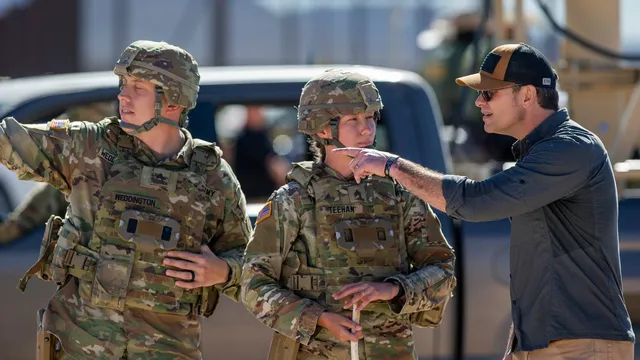
Trump administration orders expansive military buffer zone at the border
2025-06-27 09:05- The Pentagon has established a National Defense Area along the U.S.-Mexico border in response to ongoing immigration concerns.
- This new military buffer zone will allow temporary detentions of unauthorized individuals while emphasizing the commitment to interagency coordination.
- The establishment of additional NDAs signals the administration's ongoing strategy to enhance border security despite a decrease in illegal crossings.
Express your sentiment!
Insights
In a move amidst ongoing concerns about immigration, the United States has established a new National Defense Area (NDA) along the southern border with Mexico. This initiative, ordered by Defense Secretary Pete Hegseth on June 18, 2025, aims to strengthen security operations and improve coordination among agencies. Spanning 250 miles along the Rio Grande River in Texas’s Cameron and Hidalgo Counties, the NDA will allow military personnel to detain unauthorized individuals temporarily before transferring them to appropriate law enforcement. This is the third NDA created under the current administration, reflecting its commitment to addressing border security.Since President Donald Trump took office, border security has remained a prominent focus, integral to his administration's efforts. Earlier this year, with illegal crossings at record lows, Trump's administration had been accused of implementing strict measures to deter unauthorized migration. The establishment of the NDA highlights a broader trend where military involvement is increasing along the border, despite diminishing illegal crossings. The establishment of the NDA, covering a substantial stretch of the border, follows the creation of another NDA in New Mexico in April and one in West Texas in May. This series of buffer zones exemplifies the administration’s approach to repelling what has been characterized as an invasion of immigrants attempting to enter the U.S. lawfully. Each NDA will feature temporary barriers and signage to demarcate the area and will be administered by Joint Base San Antonio.The operational oversight of the NDA falls under the jurisdiction of the Joint Task Force-Southern Border, which is a segment of U.S. Northern Command (USNORTHCOM). While military personnel will not engage in law enforcement activities, they hold the authority to detain migrants entering the zone and can hand them over to the Border Patrol for further processing. Despite this crackdown on immigration, recent reports indicated a notable dismissal of trespassing charges against 98 illegal migrants who had entered into the first NDA established in New Mexico, following a ruling that they were unaware they were crossing into a military zone. The emergence of these NDAs comes at a time when illegal border crossings are reportedly decreasing, with significant drops in the number of apprehensions. In May, just under 9,000 apprehensions were recorded, starkly contrasting with the prior year under different administration circumstances, highlighting a significant shift in border dynamics.
Contexts
National Defense Areas (NDAs) are designated regions established by governments to protect strategic resources, military installations, and critical infrastructure from potential threats, particularly during times of conflict or heightened national security risks. The primary purpose of NDAs is to ensure a coordinated approach to defense and resource management, prioritizing areas that are deemed vital for the security of a nation. These areas are marked by specific restrictions on access and activities, enabling authorities to safeguard against espionage, sabotage, and other hostile actions that could undermine national security. Understanding the history and purpose of NDAs is crucial for grasping their significance in modern defense strategies. Historically, the concept of National Defense Areas emerged in response to the evolving nature of warfare and the need for states to establish secure environments during heightened tensions. The necessity for NDAs was particularly underscored during key conflicts such as World War II and the Cold War, where strategic military planning dictated the control of land and resources. As threats became more complex, especially with advancements in technology and warfare capabilities, countries began to formalize the establishment of NDAs as a preventative measure. This formalization included legislation that defined the parameters of NDAs, outlined the responsibilities of government agencies, and established protocols for activating and managing these areas in crises. The operational framework of NDAs involves collaboration between various government departments, law enforcement agencies, and military organizations to ensure the effective monitoring and enforcement of regulations within these areas. Specific protocols are often put in place to restrict civilian access and conduct thorough assessments of both existing and potential risks. By isolating critical installations within NDAs, governments can facilitate a more robust defensive posture, ensuring that assets required for national security are preserved and protected. This can also involve the implementation of advanced surveillance and reconnaissance measures to detect and deter unauthorized activities. In contemporary contexts, NDAs continue to play a pivotal role in national security strategies, especially as geopolitical tensions fluctuate and new threats emerge. The rise of cyber warfare, terrorism, and unconventional conflicts underscores the need for adaptive and proactive defense measures. Identifying areas that are susceptible to attack or disruption has become an essential component of national defense planning. As threats evolve, so too must the strategies related to NDAs, ensuring that responses remain agile and effective. Overall, the history and ongoing development of National Defense Areas reflect the dynamic nature of security challenges, underscoring the importance of proactive measures to safeguard the interests and safety of nations.